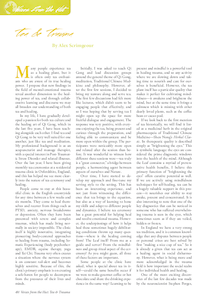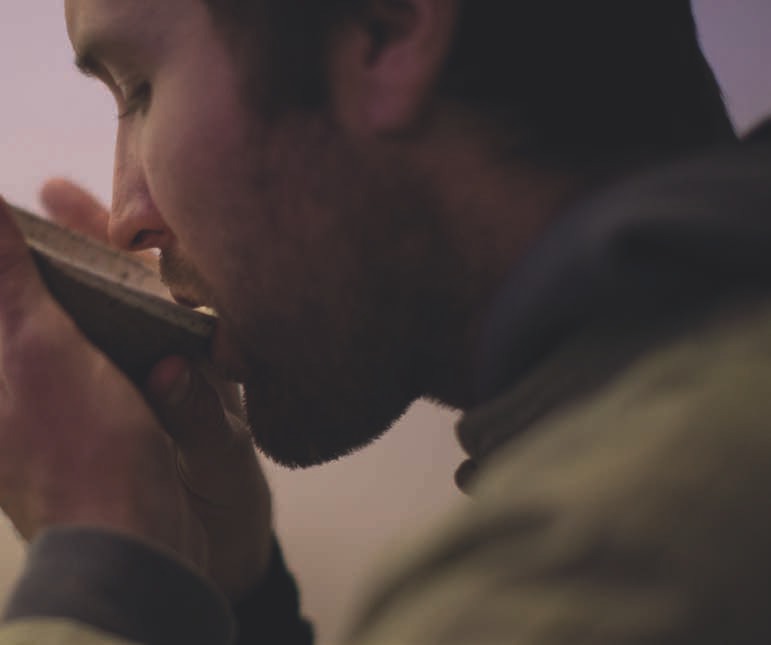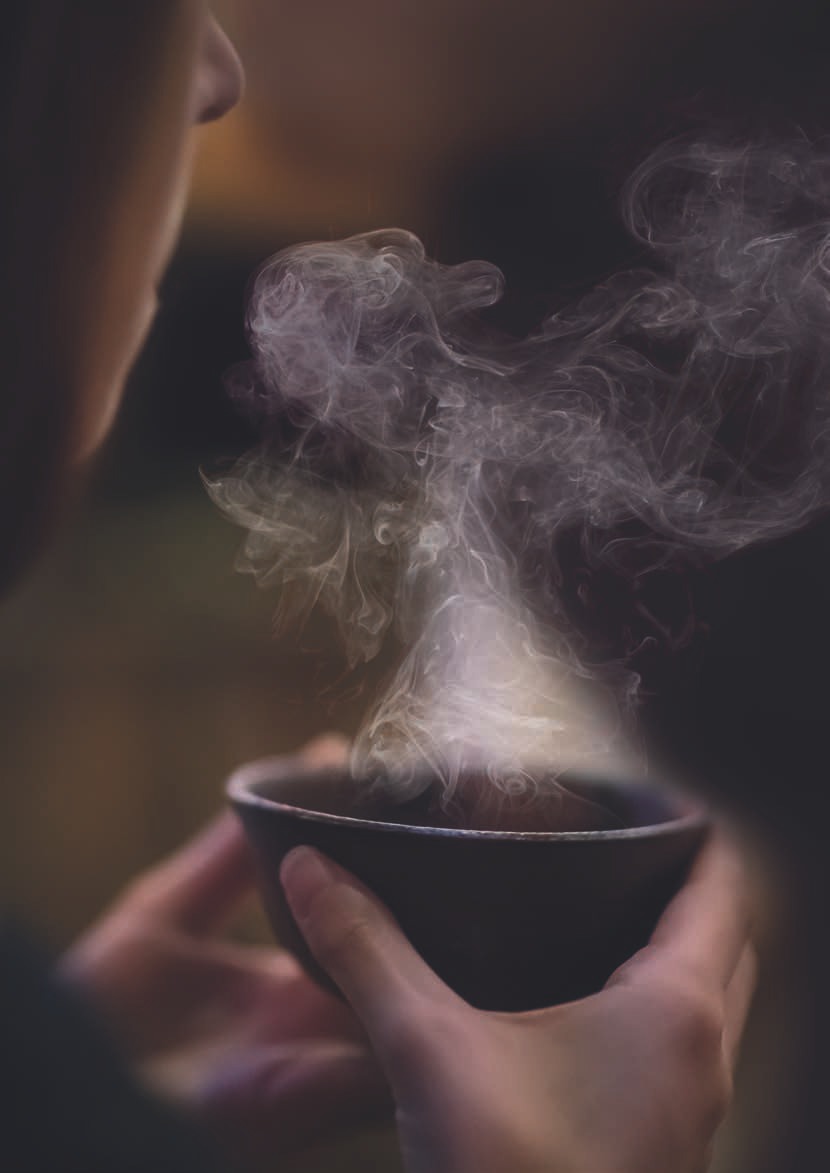
 |
|
Many people experience tea as a healing plant, but it is often only tea enthusiasts who are aware of its true healing power. I propose that new findings in the field of mental-emotional trauma reveal another dimension to the healing power of tea, and through collaborative learning and discourse we may all broaden our understanding of both tea and healing.
In my life, I have gradually developed a passion for both tea culture and the healing art of Qi Gong, which in the last five years, I have been teaching alongside each other. I find tea and Qi Gong to be very well suited for one another, just like tea and meditation. My professional background is as an acupuncturist and massage therapist, with a special interest in Post-Traumatic Stress Disorder and related illnesses. Over the last year, I have been giving monthly tea ceremonies at a residential trauma clinic in Oxfordshire, England, and this has helped me see more clearly into the nature of tea ceremony and healing.
People come to stay at this beautiful clinic in the English countryside for any time between a few weeks and six months. They come to heal themselves and recover from things such as PTSD, anxiety, nervous breakdowns or depression. Often they have been presented with severe and complex traumas, which has made living normally in society impossible. The clinic itself is highly innovative, integrating pioneering body-centered approaches to healing from trauma, including Somatic Experiencing (body psychotherapy), EMDR, equine therapy, yoga and Tai Chi. Trauma very often creates a situation where the nervous system is on constant red-alert and becomes highly sensitive. Because of this, the clinic's primary emphasis is on creating a safe-haven for people to decompress from the pressures of their lives and minds.
Initially, I was asked to teach Qi Gong and lead discussion groups around the general theme of Qi Gong, meditation, Traditional Chinese Medicine and philosophy. However, after the first few sessions, I decided to bring my teaware along and serve tea. The first few discussions had felt more like lectures, which didn't seem to be engaging people that effectively, and so I was hoping that by serving tea I might open up the space for more fruitful dialogue and engagement. The response was very positive, with everyone enjoying the tea, being present and curious through the preparation, and feeling able to communicate and be more open within the group. The participants were noticeably more open and relaxed after the session than before. It was wonderful to witness how different these sessions were - tea truly is a "great connector," a bridge between people, a harmonizing agent between aspects of ourselves and Nature.
Over time, I have started to develop my approach and fine-tune my serving style to the setting. This has been an interesting experience, and not just from witnessing the difference that tea brings to the equation, but also as a way of learning to hone my skills and adapt to different people and dynamics. I believe tea ceremony has a great potential for helping heal and resolve emotional trauma. However, the underpinnings of how it helps heal these sometimes hugely debilitating conditions throws up many questions - where is the healing coming from? The Leaf itself? From me as a guide and server? From the mindfulness and group ritual aspect of the ceremony? As you might guess, all three of these factors are important.
Some people at the clinic have asked, what is special about tea in itself - could the same benefits occur if we were to make gourmet coffee or hot chocolate and share the drinking experience in the same way? Learning to be present and mindful is a powerful tool in healing trauma, and so any activity where we are slowing down and taking time to nourish and care for ourselves is beneficial. However, the tea plant itself has a particular quality that makes it perfect for cultivating mindfulness - it awakens and brightens the mind, but at the same time it brings a calmness which is missing with other dearly loved plants, such as the coffee bean or cacao pod.
If we look back to the first mention of tea historically, we will find it listed as a medicinal herb in the original pharmacopeia of Traditional Chinese Medicine - Shen Nong's Herbal Classic. Its therapeutic quality is described simply as "brightening the eyes." This is symbolic language: the eyes are considered the prime diagnostic windows into the health of the mind. Although the Leaf contains a myriad of preventative health benefits, I believe this primary function of "brightening the eyes" offers curative potential as well. If we are actively using mindfulness techniques for self-healing, tea can be a hugely valuable support in this process - it nourishes our ability to stay awake, present and concentrated. It is also interesting to note that one of the key diagnostics that can be noticed in someone who has suffered overwhelming trauma is seen in the eyes, which sometimes seem as if they are veiled, hidden or frozen.
In England we have a very strong tea tradition, and it is common knowledge that any disputes between people or personal crises are best solved by first "making a nice cup of tea." So it is already a given that tea can act as a healing agent in social disharmony. However, what is being more and more acknowledged in the trauma field is how important the social realm is for individual health and healing.

"I believe tea ceremony has a great potential for helping heal and resolve emotional trauma. However, the underpinnings of how it helps heal these sometimes hugely debilitating conditions throws up many questions - where is the healing coming from? The Leaf itself? From me as a guide and server? From the mindfulness and group ritual aspect of the ceremony? As you might guess, all three of these factors are important."
One of the most exciting discoveries of the last few decades was made by the neuroscientist Stephen Porges, when he realized that there is another layer to our nervous system, which is critical in the stress response. His research intersects psychology, neuroscience and evolutionary biology, and has come to be called "Polyvagal Theory."
Most people are familiar with the "flight or fight" and "freeze" responses. These are instinctual mechanisms that are evolutionarily embedded into our autonomic nervous systems (ANS). When people experience trauma and are unable to process and recover from the experience, this leads the nervous system to go haywire, which becomes confused and highly sensitive - in what is termed as a "dysregulated nervous system."
The ANS is often seen as being balanced like two sides of a scale - when we are under physical or mental stress, the sympathetic aspect of the ANS is stimulated, and when we are relaxed, eating, and sleeping, the parasympathetic aspect of the ANS is stimulated. The two modes create a cascade effect through our hormonal systems, metabolism and blood circulation. Simply put, the sympathetic speeds things up and the parasympathetic slows things down. For optimal healing and regeneration, we are dependent on the parasympathetic. The nerve pathway which governs the parasympathetic is called the "vagus nerve." This stems from the lower aspect of our face and jaw, and runs down through our throat and innervates the organs of our trunk.
Polyvagal Theory highlights that the vagus nerve has two distinct branches: one that is slower and older, and another that is newer and faster. The old branch is activated in the "freeze" response; it's kind of like a default automatic shutdown when stress becomes overwhelming. This is an effective survival mechanism that is seen when an animal "plays dead" - the predator loses interest and instinctively avoids dead meat for its own safety. This happens exactly the same in humans. We faint or we "dissociate" from the body, numbing us to terror and pain. The newer branch of the Vagus is distinct to higher mammals and is specifically related to social communication. We are using this part of the nervous system instinctively all the time, in any environment when we're reading others' facial expressions or hearing their voices. This represents a new layer to the stress response - the orientation mode.
The reason why the orientation mode is so vital for humans is linked to our vulnerability throughout our infancy. Unlike many animals, we're entirely dependent on our caretakers and have evolved to use facial expression and voice as an essential bonding (and survival) skill. Even more importantly, this skill is integral to functioning socially and is also essential for our physical and mental health. Polyvagal Theory teaches us that we are constantly regulating each other's health just by conversing and reading facial expressions. When there is the slightest sign that the person we are with is detecting danger, our orientation mode picks up on this and, depending on our conditioning, kicks into the sympathetic "flight or fight" mode. When our environment and the people we are with appear safe and at ease, we are also safe and at ease, and our nervous system remains in a balanced state. In time, this understanding will be hugely significant for modern healthcare - optimal healing is dependent on a safe social and physical environment, and diminishing signs of threat and danger.
When we experience a traumatic event, our bodies have an inbuilt, evolutionary resilience that helps us survive and regain equilibrium. However, our culture and modern lifestyles have changed so rapidly in recent centuries that often it is very difficult to regain equilibrium after trauma, and our nervous systems are left in a deregulated, overly sensitized state. Stress has become so pandemic in our society that we actually don't even need a single traumatic event to knock the nervous system out of balance: the gradual buildup of physiological, emotional, social and environmental stress can be thought of as "soft trauma." Whenever we reach breaking point (i.e., when it becomes overwhelming), this can manifest in similar ways to "hard trauma" - anxiety, depression, pain and dissociation.
This way of looking at the underlying mechanisms of social interaction and stress gives us new insight into why tea ceremony can be such a powerful and sometimes profound experience for some people - there are multiple levels at work.

If you have engaged in a harmonious tea ceremony, you know in your heart and understand all of this already. Nevertheless, if we broaden our knowledge, this can empower and give more clarity to our intent, leading to more skillful interaction with tea and those whom we serve.
If you are already engaged in tea ceremony, this research and new understanding of stress and trauma will help dispel any doubt that the way you communicate, through speech or body language and facial expression, is vital to creating harmony and healing through tea. Polyvagal Theory gives credence to the old Chinese saying that "the doctor is the medicine." This goes to re-emphasize how important self-cultivation and meditation is for doctors and for self-healing. When you have a bright-hot charcoal ember and a log of wood is placed close by, the dry log will spark up into a blaze. This is an analogy for when a healer's spiritual Light is clear and strong; just being in their presence can activate healing and change.
A different line of research that gives further weight to this concept is that of the HeartMath Institute, which clearly shows that when a state of mental-physical coherence is achieved in one person, this spontaneously arises in those who are close by. The process by which this coherence is developed is a simple method of breathing slowly whilst resting a peaceful awareness on the area of the heart, focusing on the changes in that area. The heart's electromagnetic field becomes coherent with that of the brain, and this field extends out from the body and "entrains" those who are close by. It might seem far-fetched, but this process of coherence and entrainment can be clearly measured.
The first step when working with either "soft" or "hard" trauma is analogous to the first step of Qi Gong: "gathering the Qi." This simply means slowing down, centering, creating a safe environment, grounding and setting an intention. When we can start to cultivate mindfulness and remain present in the moment-to-moment and in the body, then we have built the stability of mind to take the next step in beginning to process and release old patterns and traumas without getting knocked off balance and retraumatized.
When mindfulness slips and stability is lost, it can either fall towards the sympathetic mode of speeding up, becoming restless or anxious, or towards parasympathetic dissociation, which is a spaced-out, disembodied, dreamy state. Through practice, we can become familiar with this spectrum of experience and learn to self-regulate, and set the stage for our own healing or help co-regulate and assist others in this process. When tea is combined with simple mindfulness and embodiment practices, it offers a strong support to begin taking these first steps. It is also interesting to note that the sensitivity skills that are developed when drinking tea are superb embodiment exercises in themselves, as the main pathway of the Vagus nerve runs from the face, down through the throat, and into the core of the body.
When I first began serving tea at the clinic, I was unsure what would be the ideal tea to serve and the most suitable method of preparation. Initially, I served GABA oolong tea, white tea or aged white tea, as I wanted to avoid teas that might be too stimulating and potentially agitating. This worked well, but since then I've come to realize that the main factor in avoiding agitation is actually not the tea type, but the quality of the leaf. As such, organic living tea is key for healing and good health. Because I never know in advance how many people might turn up to the sessions, I've learned that it's best to come prepared for either gongfu, if there are a handful of people, or for bowl tea if there are more. Being spontaneous allows me to attend fully to those around me, rather than relying on a fixed plan for how I would like things to go. This is surely a valuable life lesson in these changeable times.
When assessing what type of tea might be appropriate for someone, it is helpful to think back to the spectrum of experience mentioned earlier. If people seem agitated, restless and leaning towards sympathetic dominance, we could consider this as an excess Yang state of being, and conversely, if people seem dissociated, spaced-out and not rooted in their body, this could be seen as an excess Yin state of being. We can then adjust both our behavior and the tea we serve to harmonize with the group. Teas that accent the surface qualities of color, fragrance and taste can help harmonize the Yang, while teas that accent the deeper qualities of texture, throat-feel, body-feel and Qi can help harmonize the Yin. Our attention can also be specifically drawn to these qualities in any particular tea, as no tea is definitively Yin or Yang.
When aiming to create harmony within a group, I believe we can learn from the Daoist wisdom of being like water. Rather than projecting or enforcing any state of mind through our space, we yield to what is around us and accept what is. We can see if we can release ourselves to the stillness in the room, or release into our breath and listen for the stillness in the background of our body. Ideally, we rest in a state of embodied presence and coherence. If we feel safe and at home in ourselves, this will help create an environment of safety for others. The heaviness that often surrounds people who are stressed can be counteracted by generating a sense of lightheartedness within, and radiating this through one's voice and expression.
I continue to be fascinated by all aspects of tea practice, and by its particular relevance and helpfulness in modern times. The old wisdom that runs like gold through the history of Cha Dao and through the indigenous traditions of the East, holds incredible potential for the healthcare crisis that is unfolding in modern society. It is up to us to draw together new ways of applying these old traditions and adapting to changing times.

